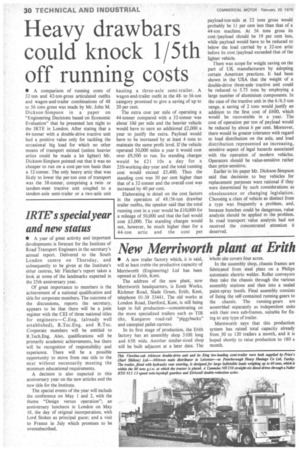Heavy drawbars could knock 1/5th off running costs
Page 32

If you've noticed an error in this article please click here to report it so we can fix it.
• A comparison of running costs of 32-ton and 42-ton-gross articulated outfits and wagon-and-trailer combinations of 48 to 56 tons gross was made by Mr. John M. Dickson-Simpson in a paper on "Engineering Decisions based on Economic Evaluation" that he presented last night to the IRTE in London. After stating that a 44-tonner with a double-drive tractive unit had a positive value only for tackling the occasional big load for which no other means of transport existed (unless heavier artics could be made a lot lighter) Mr. Dickson-Simpson pointed out that it was no cheaper to run on a cost-per-ton basis than a 32-tonner. The only heavy artic that was likely to lower the per-ton cost of transport was the 38-tonner, comprising a twinor tandem-steer tractive unit coupled to a tandem-axle semi-trailer or a two-axle unit hauling a three-axle semi-trailer. A wagon-and-trailer outfit in the 48to 56-ton category promised to give a saving of up to 20 per cent.
The extra cost per mile of operating a 44-tonner compared with a 32-tonner was about 10d per mile and the heavier vehicle would have to earn an additional £2,000 a year to justify the extra. Payload would have to be increased by at least 4 tons to maintain the same profit level. If the vehicle operated 50,000 miles a year it would cost over £9,500 to run. Its standing charges would be £21 lOs a day for a 250-working-day-year and the total running cost would exceed £5,400. Thus the standing cost was 30 per cent higher than that of a 32-tonner and the overall cost was increased by 40 per cent.
Elaborating in detail on the cost factors in the operation of 48/56-ton drawbar trailer outfits, the speaker said that the total running cost in a year would be £10,000 for a mileage of 50,000 and that the fuel would cost £3,000. The standing charges would not, however, be much higher than for a 44-ton artic and the cost per payload-ton-mile at 52 tons gross would probably be 11 per cent less than that of a 44-ton machine. At 56 tons gross its cost /payload should be 19 per cent less, while payload would have to be reduced to below the load carried by a 32-ton attic before its cost /payload exceeded that of the lighter vehicle.
There was scope for weight saving on the part of UK manufacturers by adopting certain American practices. It had been shown in the USA that the weight of a double-drive three-axle tractive unit could be reduced to 5.75 tons by employing a large number of aluminium components. In the case of the tractive unit in the 6/6.5-ton range, a saving of 2 tons would justify an addition to the first cost of £600, which would be recoverable in a year. The cost of operation per ton of payload would be reduced by about 6 per cent. Moreover, there would be greater tolerance with regard to load distribution on the axle, and load distribution represented an increasing, sensitive aspect of legal hazards associated with the operation of modern vehicles. Operators should be value-sensitive rather than price-sensitive.
Earlier in his paper Mr. Dickson-Simpson said that decisions to buy vehicles for replacement purposes were rational if they were determined by such considerations as obsolescence or changing legislation. Choosing a class of vehicle as distinct from a type was frequently a problem, and, because hunches could be dangerous, value analysis should be applied to the problem. In road transport value analysis had not received the concentrated attention it deserved.














































































































































































































